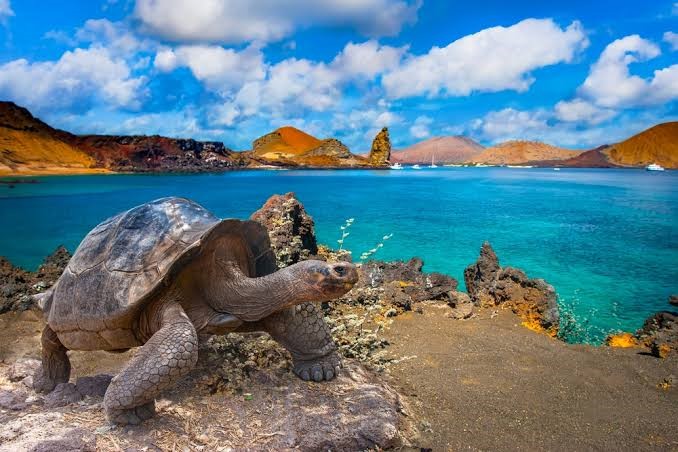
Galapagos Islands

04.11.2023
Galapagos Islands , Daily Current Affairs , RACE IAS : Best IAS Coaching in Lucknow
|
For Prelims:Galapagos Islands,Coral reefs For mains paper 3 :Types of Coral Reefs,Importance of Coral Reefs |
WHY IN NEWS?
Scientists recently found two new coral reefs and two unexplored seamounts in the Galapagos Islands.
About Galapagos Islands
- It is an archipelago of volcanic islands.
- The islands are located in the eastern Pacific Ocean, 973 km off the west coast of South America.
- They are distributed on each side of the equator in the Pacific Ocean, surrounding the center of the Western Hemisphere.
- It belongs to the Republic of Ecuador that lies 926 km to the east.
- The islands are known for their large number of endemic species that were studied by Charles Darwin during the second voyage of HMS Beagle.
- The islands are located at the Galapagos Triple Junction. The Galapagos Triple Junction is a geological area in the eastern Pacific Ocean several hundred miles west of the Galapagos Islands where three tectonic plates - the Cocos Plate, the Nazca Plate and the Pacific Plate - meet.
- The archipelago is precisely located on the Nazca Plate (a tectonic plate), which is moving east/southeast, diving under the South American Plate at a rate of about 2.5 inches (6.4 cm) per year.
- The archipelago is mainly characterized by a mixture of a tropical savanna climate and a semi-arid climate. It also transits into a tropical rainforest climate in the northwest.
- Mount Azul, at 5,541 feet is the highest point of the Galapagos Islands.
- The islands are well known for their distinctive endemic species, including giant tortoises, finches, flightless cormorants, Galápagos lava lizards and marine iguanas, which evolved to adapt to islands' environments.
- In 1978 the islands were designated a UNESCO World Heritage site.
- Galápagos marine iguana is a species of iguana found only on the Galápagos Islands (Ecuador).
Coral reefs
- Coral reefs are built by and made up of thousands of tiny animals—coral “polyps”—that are related to anemones and jellyfish.
- Polyps are shallow water organisms which have a soft body covered by a calcareous skeleton. The polyps extract calcium salts from sea water to form these hard skeletons.
- The polyps live in colonies fastened to the rocky sea floor.
- The tubular skeletons grow upwards and outwards as a cemented calcareous rocky mass, collectively called corals.
- When the coral polyps die, they shed their skeleton [coral] on which new polyps grow.
- The cycle is repeated for over millions of years leading to accumulation of layers of corals [shallow rock created by these depositions is called reef].
- These layers at different stages give rise to various marine landforms. One such important landform is called coral reef.
- Coral reefs over a period of time transform or evolve into coral islands (Lakshadweep).
- The corals occur in different forms and colours, depending upon the nature of salts or constituents they are made of.
- Small marine plants (algae) also deposit calcium carbonate contributing to coral growth.
Types of Coral Reefs:
Fringing Reef: The coral reefs that are found very close to the land and forms a shallow lagoon known as Boat Channel are called Fringing Coral Reefs. The Fringing Reefs develop along the islands and the continental margins. They grow from the deep bottom of the sea and have their seaward side sloping steeply into the deep sea. Fringing Reefs are the most commonly found coral reefs among the three. For example Sakau Island in New Hebrides, South Florida Reef.
Barrier Reef: Barrier Reefs are considered as the largest, highest and widest reefs among the three coral reefs. They develop off the coast and parallel to the shore as a broken and irregular ring. Being the largest reef among the all, they run for 100kms and is several kilometres wide. One example of Barrier Reef is the Great Barrier Reef of Australia which is 1200 mile long.
Atolls: An atoll can be defined as a reef that is roughly circular and surrounds a large central lagoon. This lagoon is mostly deep having a depth of 80-150 metres. The atolls are situated away from the deep sea platforms and are found around an island or on a submarine platform in an elliptical form. For example Fiji Atolls, Suvadivo in Maldives and Funafoothis Atoll of Ellice.
Importance of Coral Reefs
- protect coastlines from the damaging effects of wave action and tropical storms
- provide habitats and shelter for many marine organisms
- They are the source of nitrogen and other essential nutrients for marine food chains
- assist in carbon and nitrogen fixing
- help with nutrient recycling.
- The fishing industry depends on coral reefs because many fish spawn there and juvenile fish spend time there before making their way to the open sea
The Great Barrier Reef generates more than1.5 billion dollars every year for the Australian economy, from fishing and tourism